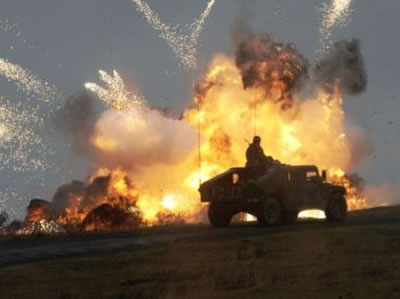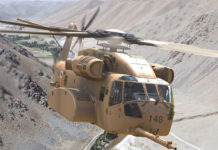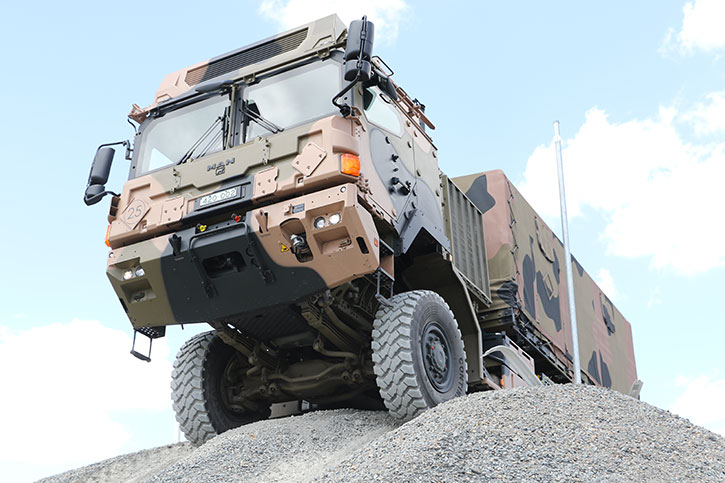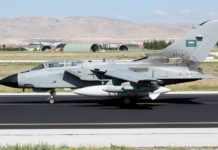Improvised Explosive Devices (IED) have now added a new dimension to battlefield injuries: Injuries and even deaths among troops who have no external signs of trauma but whose brains have been severely damaged. The insurgency war in Iraq and Afghanistan has reinstated one of the worst afflictions of World War I trench warfare: shell shock.
The detonation of any powerful explosive generates deadly blast effect, propagated in a wavefront of high pressure that spreads out at 1,600 feet per second from the point of explosion, traveling rapidly over hundreds of yards. Normally, the detonation propels fragments of shrapnel at a high velocity. Where fragments penetrate the skull, such injuries (referred to as ballistic trauma) are considered “conventional” traumatic brain injuries; they are easy to diagnose, by clearly visible entry wounds, which are treated in a surgical procedure – foreign bodies are removed from the brain, and the patient is given a type of drug to prevent further damage to the brain neurons. Yet, blasts also causes invisible damage to the brain, as the blast wave tremors the soft tissue, smashing it against the hard surface of the inner skull.
Actually, the lethal blast wave strikes twice. The initial shock wave of very high pressure is followed closely by the “secondary wind”: a huge volume of displaced air flooding back into the vacuum under high pressure. Neither a helmet nor the body armor protect the body from the risk of such wave fronts. These sudden and extreme differences in pressures – routinely 1,000 times as great as atmospheric pressure – lead to significant neurological injury including severe concussions, resulting in loss of consciousness and obvious neurological deficits such as blindness, deafness and mental retardation. Blast waves causing traumatic brain injuries can leave a 19-year-old soldier who could easily run a six-minute mile unable to stand or even think.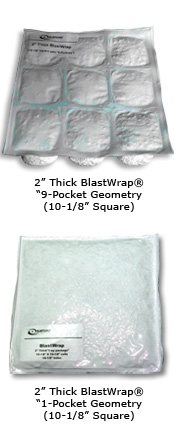
It is little known, that thousands of troops have already experienced the blasts of IED. If they are knocked unconscious, they too are evacuated to a field hospital for evaluation. But if they survive the explosion and do not complain of a problem, they remain on duty. Yet, Specialists in brain injury know all too well that people can suffer brain problems without losing consciousness. One of the most frightening aspects of brain injury is that brain-injured people often lose the ability to know something is wrong.
According to the Department of Veterans Affairs statistics, about 1,800 U.S. troops are already suffering from traumatic brain injuries caused by penetrating wounds. But neurologists worry that many more – at least 30 percent of the troops who have been engaged in active combat for four months or longer in Iraq and Afghanistan – are at risk of potentially disabling neurological disorders from the blast waves of IEDs. The US Department of Defense has acknowledged that Traumatic Brain Injury (TBI) as a “significant health concern” and vowed to identify it among active duty troops. But many new cases are likely to emerge as troops transition to civilian life as veterans. Military records show that 60% of the 25,000 war injuries to date resulted from explosive blasts like IED’s or roadside bombs. And nearly 3,000 of the wounded are currently being treated for severe traumatic brain injury or TBI. Traumatic brain injury has rapidly become the signature wound of soldiers returning from Iraq.
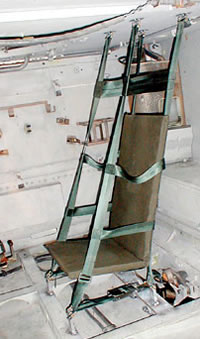 Due to the growing magnitude threat of the IEDs which are lately used by insurgents in Iraq, Afghanistan and Lebanon, efforts are being made to develop effective counter-measures, mitigating the blast effect and enhance troops protection and survival. Among these are suspended seats, which soften the shockwave by slowing its propagation through energy absorbing and head restraining harness which forms the seat. This design, first introduced by the German companyAutoflug, protects soldiers from both belly charges which induce vertical shockwave, as well as road-side IEDs, which induce a lateral effect. Another patent pending design is currently in development at Plasan Sasa.
Due to the growing magnitude threat of the IEDs which are lately used by insurgents in Iraq, Afghanistan and Lebanon, efforts are being made to develop effective counter-measures, mitigating the blast effect and enhance troops protection and survival. Among these are suspended seats, which soften the shockwave by slowing its propagation through energy absorbing and head restraining harness which forms the seat. This design, first introduced by the German companyAutoflug, protects soldiers from both belly charges which induce vertical shockwave, as well as road-side IEDs, which induce a lateral effect. Another patent pending design is currently in development at Plasan Sasa.
Mobius PS offers another patent-pending blast protection technology, based on a simple approach, utilizing a single, factory tunable element, manufactured to meet preset EA characteristics. The fixed profile Energy Absorption element performs its mission with continuous self-adjusting dynamic attenuation, providing maximum protection to full range of occupants weights, from light 5th percentile female up to heavy 95th percentile male and beyond.
This implementation provides a straightforward attachment of crew seats, passenger seats or benches, to the floor or to the walls, without the need for motion guides, rails or complex suspension and isolation techniques. Using light, strong seat frames and attachments, the protected seats are validated to face multi-directional impacts, from blast or accident and crash scenarios. To restrain the occupants to their seats, 4-5 point safety belts, all-belts-to-seat, adjustable head-rest (available with side supports) are also provided.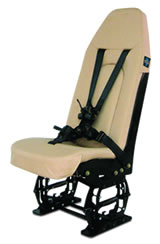
Advanced blast mitigation materials used in modern protected vehicles also contribute to the reduction of blast effects. Usually, these materials are embedded in the vehicle’s floor to offset some of the explosion. Blast mitigating pads designed to reduce brain damage in case of blast are provided as a standard with most types of modern ballistic helmets. Such pads are also offered as add-on kits for standard helmets.
With the war in Iraq already in its fifth year, one of its abnormal indications are, that this is not a conflict of death, although every soldier killed in action represents a human tragedy in itself, but more of a war of disabilities, Thus, the symbol of this protracted bloodletting is not the cemetery, as were former twenty century wars, but the orthopedic ward and as of lately, the neurosurgical unit. The men and women inside those units may have come home alive, but are missing arms and legs. Many are unable to see, hear or remember who they were before being hit by a roadside bomb. Coping with the growing number of such patients, leaves the military medical profession with a huge professional challenge, in order to find new methods in treating such a phenomena, which was sofar unexperienced in warfare.
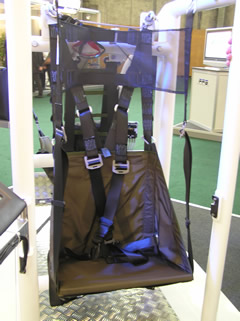 One of the reasons for such complexity is that frequently, traumatic brain injury relates to another medical Phenomena called Post Traumatic Stress Disorder (PTSD). The problem lies in the overlapping symptoms, such as increased anxiety, short attention span, limited concentration, problematic lapses in memory. Once these symptoms occur together, they can make a diagnosis extremely difficult, as they are mixing several disciplines, all concerning human behavior under acute stress situations. Detecting and recognizing the symptoms are difficult, treatment and healing are made even more complicated.
One of the reasons for such complexity is that frequently, traumatic brain injury relates to another medical Phenomena called Post Traumatic Stress Disorder (PTSD). The problem lies in the overlapping symptoms, such as increased anxiety, short attention span, limited concentration, problematic lapses in memory. Once these symptoms occur together, they can make a diagnosis extremely difficult, as they are mixing several disciplines, all concerning human behavior under acute stress situations. Detecting and recognizing the symptoms are difficult, treatment and healing are made even more complicated.
PTSD, originally named “Shell Shock” during the First World War, when soldiers were subjected to long periods of continuous bombardment though high explosive shells. This became a physical/psychological phenomena, hitherto unknown to the mental treatment community. During the Second World War the term “Combat Fatigue” was known, but still regarded, in most cases, as curable through periods of rest and recuperation. In extreme incidents, such as the famous ill-treatment of a battle shocked youngster by General George S. Patton III, in Sicily, only highlighted the ignorance by commanders, of what was to become a seriously recognized factor in modern warfare.
The Vietnam War saw thousands of young Americans, seemingly unscathed by combat but suffering from emotional and even physical disorders, which virtually crippled them from resuming their normal routine by becoming near permanent psychiatric cases. The American Psychiatric Association included the new diagnostic criteria for such cases in terms of Post Traumatic Stress Disorder in 1980.
The Israeli psychiatry and psychological community had, at the same time researched the direct experiences of soldiers suffering from what was termed “Combat Stress Reactions” (CSR) in the aftermath of the 1973 Yom Kippur War and the even more serious effects of the 1982 Lebanon Invasion and the following long drawn-out anti-guerilla campaign. The Israeli researchers found that nearly 30% of the overall casualties were the result of CSR.
One of the most significant factors in PTSD among veterans is their perception that the cause which they are fighting for is not publicly supported. For example, such a situation existed in the 1970’s among returning Vietnam veterans, in which the traditional horrors of war were magnified by public condemnation, or ignorance, in unprecedented manner. The mass incidence of psychiatric disorders among Vietnam veterans skyrocketed to nearly a third of the 3.5 million soldiers who fought in this war!
A similar condition was perceived in Israel in the aftermath of the 1982 Lebanon War, when the Israel Defense Forces (IDF) became involved in the 18 year stagnating war in South Lebanon, which was regarded by the Israeli public as superfluous and lacking national consensus. While not so severe, the protracted counter-terror combat in the densely populated Palestinian urban environment in the West Bank and Gaza, has already increased the number of psychiatric cases among the young Israeli soldiers, exposed to hazards which they were totally unfamiliar with before they joined national service. Sofar, there is only insufficient evidence over PTSD in the aftermath of last summer’s Lebanon war.
 An Israeli professor who is studying the long term effects of war on the soldiers, who fight it, is now sharing her knowledge with US counterparts in an attempt to provide better therapy for American servicemen and women returning home from the battlefields of Iraq. Over the last 20 years, Tel Aviv University Professor Zahava Solomon has conducted research into the psychological consequences of war and terror. According to Professor Solomon’s research, which has revolutionized the way Israeli soldiers are treated in battle, the best way to combat stress is to give immediate treatment while soldiers are still on the front lines. The IDF has already established a wide range of “Forward Psychiatry”, even to combat units, through trained medical personnel, which render on-the-spot treatment, ordering the more severe cases for immediate evacuation. Special mental health care centers were also established to cure PTSD patients and return them as early as possible to combat duty. Statistical figures from official sources indicate that during the 1982 Lebanon War, with proximal treatment 90% of CSR casualties returned to their unit, usually within 72 hours. However, with rearward treatment only 40% returned to their unit indefinitely.
An Israeli professor who is studying the long term effects of war on the soldiers, who fight it, is now sharing her knowledge with US counterparts in an attempt to provide better therapy for American servicemen and women returning home from the battlefields of Iraq. Over the last 20 years, Tel Aviv University Professor Zahava Solomon has conducted research into the psychological consequences of war and terror. According to Professor Solomon’s research, which has revolutionized the way Israeli soldiers are treated in battle, the best way to combat stress is to give immediate treatment while soldiers are still on the front lines. The IDF has already established a wide range of “Forward Psychiatry”, even to combat units, through trained medical personnel, which render on-the-spot treatment, ordering the more severe cases for immediate evacuation. Special mental health care centers were also established to cure PTSD patients and return them as early as possible to combat duty. Statistical figures from official sources indicate that during the 1982 Lebanon War, with proximal treatment 90% of CSR casualties returned to their unit, usually within 72 hours. However, with rearward treatment only 40% returned to their unit indefinitely.
With her experience, Professor Solomon is recognized as one of the world’s leading experts in combat trauma. In fact, with the lessons Israel’s ‘natural laboratory’ in PTSD provides, offers valuable material for researchers, helping them discover new solutions to help treat those who suffer from PTSD and a range of other psychological illnesses.

